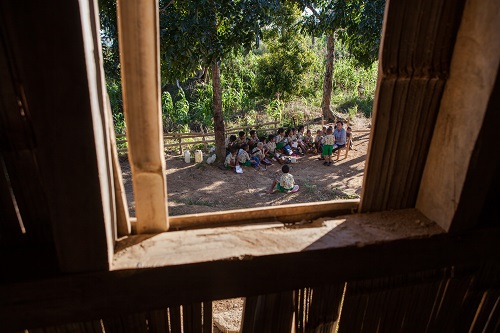Waktu menujukkan hampir pukul 07.30 WITA dan kepala sekolah serta guru-guru SDN Mboeng di Desa Kaju Wangi, Kecamatan Elar, salah satu desa sangat tertinggal di Kabupaten Manggarai Timur, Nusa Tenggara Timur, bergiliran mengambil foto menggunakan ponsel.
Mereka bukan sedang memperbarui foto mereka untuk dipasang di media sosial. Sesi foto ini merupakan bagian dari Program Rintisan KIAT Guru yang bertujuan untuk meningkatkan kualitas layanan pendidikan di desa sangat tertinggal melalui pemberdayaan masyarakat dan pengaitan pembayaran Tunjangan Khusus Guru dengan kehadiran guru atau kualitas layanan guru.
Program Rintisan ini merupakan kolaborasi antara Kementerian Pendidikan dan Kebudayaan, Tim Nasional Percepatan Penanggulangan Kemiskinan (TNP2K) dan lima pemerintah kabupaten PDT, salah satunya Manggarai Timur. Program ini diimplementasikan oleh Yayasan BaKTI, dengan dukungan teknis dari World Bank dan pembiayaan dari Pemerintah Australia dan USAID.
Kehadiran guru telah menjadi salah satu tantangan di desa ini, karena beberapa guru baru datang pukul 09.00, 90 menit setelah kelas seharusnya dimulai, atau malah tidak hadir sama sekali. Pada kunjungan mendadak yang dilakukan ke SDN Mboeng pada 31 Oktober 2016, ternyata satu dari enam guru yang memiliki jadwal mengajar di hari itu tidak hadir di sekolah, setara dengan tingkat kemangkiran guru sebesar 17 persen. Alasan ketidakhadirannya adalah sedang menghadiri pelatihan di kecamatan sebelah. Angka ini selaras dengan survei awal yang dilakukan World Bank di 270 sekolah yang masuk dalam Program Rintisan KIAT Guru yang menunjukkan tingkat kemangkiran guru sebesar 25,4 persen. Survei yang dilakukan oleh Analytical and Capacity Development Partnership (ACDP) pada 2014 menunjukkan tingkat kemangkiran guru di sekolah di daerah terpencil sebesar 19,3 persen, dua kali lipat dari angka di tingkat nasional, yaitu 9,4 persen.
.jpg)
Seorang guru mengambil foto menggunakan KIAT Kamera, aplikasi berbasis Android yang terdapat dalam ponsel
khusus, di awal dan akhir kegiatan mengajar. Waktu yang tercatat di ponsel kemudian dikumpulkan pada akhir
bulan sebagai bukti kehadiran guru. (TNP2K/Fauzan Ijazah)
SDN Mboeng telah memberlakukan satu dari tiga model intervensi KIAT Guru sejak April 2017, di mana Tunjangan Khusus diberikan kepada guru berdasarkan tingkat kehadiran mereka di sekolah, setelah diverifikasi oleh perwakilan masyarakat.
Kepala sekolah dan guru wajib mengambil absensi dengan aplikasi berbasis android KIAT Kamera, dengan kesepakatan jam masuk paling lambat pukul 07.30 di pagi hari dan jam pulang paling awal pukul 12.30 di siang hari. Kemudian, setiap akhir bulan, masyarakat akan mengecek kembali absensi guru dan mengevaluasi kinerja layanan guru menggunakan Formulir Layanan Guru. Sejauh ini, intervensi tersebut berhasil mengurangi tingkat kemangkiran dan keterlambatan guru.
Sejak April 2017, tidak ada lagi guru yang terlambat. Hal ini juga menular ke murid. Melihat guru-guru mereka begitu disiplin, anak-anak pun melakukan hal yang sama. Mereka sekarang memiliki perilaku yang lebih baik dan jarang datang terlambat, meskipun banyak dari mereka harus berjalan kaki sekitar 30 menit hingga satu jam ke sekolah,” kata Kader KIAT Guru Andreas Jemahang yang anak laki-lakinya bersekolah di SD tersebut.
Bersama dengan Kelompok Pengguna Layanan (KPL), yang terdiri atas sembilan orang tua murid dan tokoh masyarakat, Andreas mengevaluasi tingkat kehadiran dan kinerja layanan guru berdasarkan indikator janji layanan yang telah disepakati bersama antara guru dan masyarakat. Berdasarkan rekomendasi dari para murid, yang dikonsultasikan oleh tim KIAT Guru di awal implementasi, ada sejumlah janji yang disepakati, mulai dari datang tepat waktu di sekolah, tidak menggunakan hukuman fisik pada anak-anak hingga lebih kreatif dalam mengajar, misalnya dengan menggunakan alat peraga atau mengadakan sesi belajar di luar kelas.
Seiring meningkatnya kinerja guru, demikian juga dengan kemampuan para murid, seperti terlihat dalam studi awalan pengukuran kemampuan belajar dan tes cepat kemampuan literasi dan numerasi murid. “Studi awal pengukuran kemampuan belajar yang dilakukan pada September 2016 menunjukkan bahwa siswa kelas 3 memiliki kekurangan dalam membaca. Pada bulan Juni [2017], diadakan tes cepat kepada para murid yang sama dan hasilnya sungguh menggembirakan.

Memenuhi harapan siswa, guru-guru di SDN Mboeng bergiliran mengadakan kegiatan belajar mengajar di luar
kelas atau di perpustakaan. (TNP2K/Fauzan Ijazah)
Enam murid kini dapat membaca dengan baik, dua murid memenuhi standar murid kelas 2, dua murid memenuhi standar kelas 3 dan bahkan ada satu siswa yang memenuhi standar membaca kelas 4,” ujar Wali Kelas 3 Karolina Lantu.
Siswa kelas 6 Sabina Rantos mengatakan bahwa ia senang sekali kini para guru mau mengadakan kegiatan belajar di luar kelas, seperti saat belajar tentang Ilmu Pengetahuan Alam.
“Rasanya lebih menyenangkan,” kata Sabina, yang harus berjalan selama dua jam setiap harinya untuk pergi dan pulang sekolah.
(Hera Diani)